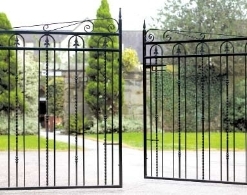We know just how exciting it can be to make home improvements that instantly elevate the value of your home and transform the appearance of your property. That’s certainly the case when replacing old, tired, and weak fencing with a robust barrier brimming with character. Wrought iron fencing has remained popular in the UK for decades – particularly for owners of period properties seeking to maintain that timeless charm. That said, this form of fencing is enjoying a resurgence up and down the country for modern homes and new builds too.
If you’re looking to add a metal fence that stands the test of time, you need a solid foundation. When any fence installation is not carried out correctly, problems can arise. Your once-beautiful fencing may show signs of sagging, impacting its appearance and structural integrity. Fortunately, we’re here to guide you through the process of ensuring that your new fencing remains attractive, reliable, and strong for years to come. Stay with us as we provide tips on how to secure your fence's foundation with concrete and make the most of your new investment.
Make sure your fence is set in a concrete foundation
Concrete footings are ideal for most forms of metal fencing, especially wrought iron, which can be particularly heavy. The best starting point is to mark out the area for your fencing and then use a Shuv-Holder (post hole digger) to create a hole that’s at least 2 feet deep. If you are installing wooden fences, be sure to add a small layer of gravel (around 2 inches) at the bottom of the hole to help with drainage and prevent the fence post from rotting over time. Once the prep work is done, position the post in the hole, pour in the concrete, and hold it in place for a few minutes until the concrete begins to set. We recommend leaving the concrete to completely set overnight before slotting fence panels into the posts. If you're not confident installing the posts yourself, always speak to an expert. They will know exactly how much concrete needs to be used for each fence post, taking your soil type and locality into account. This is an important step to ensure the posts are firmly secured - so don't be afraid to ask for help.
What happens if I do not use concrete?
In the UK, it's common to see fence posts anchored with gravel or fence post spikes. Gravel is known for facilitating moisture drainage, but it's not as secure or robust as a concrete footing, especially where metal fencing is concerned. Gravel is also highly susceptible to shifting due to harsh weather conditions, meaning your fence may start to sag over time.
Fence post spikes are easy to install as they require no digging and are cheaper than concrete. Ultimately, making the right fencing choices can help you save both time and money in the long run. Without a concrete footing, your fence may not stand strong for as long, and you could end up with costly repair bills. We favour the ‘right first time’ approach.
Where can I purchase new fencing for my property?
If you're on the lookout for fresh new fencing or if you need expert advice, don't hesitate to contact Wrought Iron Gates Direct. We provide an extensive selection of garden gates, driveway gates, side gates, estate gates, and more – all available at highly competitive prices. Our team of professionals are ready to help you select the perfect gate or fencing for your home.



